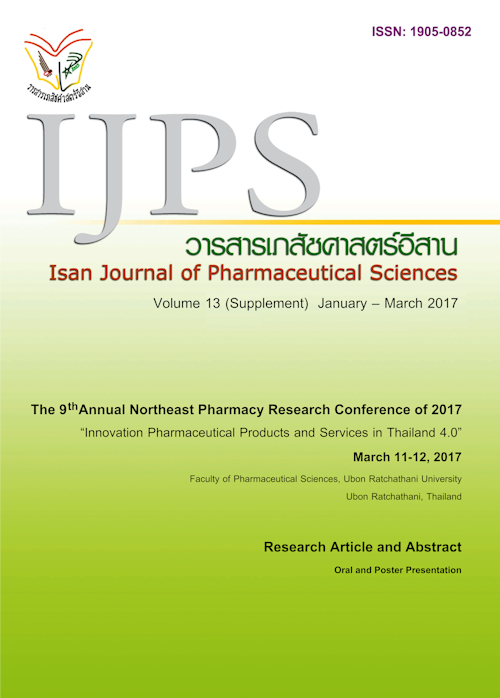Development of verapamil hydrochloride orodispersible tablets using sublimation method by microwave irradiation
Main Article Content
Abstract
Introduction: British Pharmacopoeia (BP) has defined orodispersible tablets as the uncoated tablets intend to be placed in the mount where they disperse rapidly within 3 min. They have enhanced patient compliance, particularly in pediatric and geriatric patients who have a difficulty in swallowing. In general, their characteristics show high porosity and fragile as preparing by the lyophilization technique. As such, they need to use the expensive and special package. Therefore, several attempts have been investigated to develop the desirable hardness with rapid disintegration and simple producing process such as direct compression method. To study the influence of sublimating agents and diluents on the characteristics of ODTs of verapamil HCl treated with microwave irradiation. Methods: ODTs composed of verapamil HCl (40 mg), sweetening agent (10 mg), adsorbents (5 mg), sublimating agents such as ammonium bicarbonate (10 mg) and diluents including Avicel PH 102 and mannitol adjusted to 260 mg of tablet weight. Compressed to tablet with hydraulic compactor by direct compression method and then treated with microwave oven at power of 900 watts for 6.30 min. The characteristics of tablets including hardness, friability, disintegration time, content uniformity and in vitro dissolution were determined. Results: ODTs of verapamil HCl consisted of ammonium bicarbonate and the mixture of Avicel PH 102 and Mannitol (ratio 1:1), as sublimating agent and diluents, respectively, demonstrated the desirable characters. They presented 6.083±0.67 kg of hardness with low friability. They disintegrated within 6.4±1.9 min. The content of active drug was within 90.0-110.0% and showed the maximum dissolution rate. Conclusion: Heat generated from microwave irradiation caused the sublimating agent sublimed and produced the porosity within tablets. These led to the rapid disintegration and dissolution of tablets. Heat generated from microwave irradiation caused a molten sugar alcohol and consequently increased the tablet strength. These provided the appropriate characteristic of tablets.
Article Details
In the case that some parts are used by others The author must Confirm that obtaining permission to use some of the original authors. And must attach evidence That the permission has been included
References
British Pharmacopoeia. Vol. I&II, London: Medicines and Healthcare Products Regulatory Agency,2015.
British Pharmacopoeia. Vol. III, London: Medicines and Healthcare Products Regulatory Agency,2015.
BuakaewP, Sara S. Development of oral disintegrating tablets using sublimation technique with microwave irradiation. Senior project Report: Ubon Ratchathani University; 2015; 1-29.
Kappe C. Controlled Microwave Heating in Modern Organic Synthesis. Angewandte Chemie International Edition. 2004; 43 (46): 6250-6284.
Kumar V, Gohain M, Som S, Bezuindenhoudt B, Swart H. Microwave assisted synthesis of ZnO nanoparticles for lighting and dye removal application. Physica B Condens Matter. 2016; 480: 36-41.
Otsuka M, Maeno Y, Fukami T, Inoue M, Tagami T, Ozeki T. Solid dispersions of efonidipine hydrochloride ethanolate with improved physicochemical and pharmacokinetic properties prepared with microwave treatment. Eur J Pharm Biopharm. 2016; 108: 25-31.
Sano S, Iwao Y, Kimura S, Itai S. Preparation and evaluation of swelling induced-orally disintegrating tablets by microwave irradiation. Int J Pharm. 2011; 416 (1): 252-259.
Sano S, Iwao Y, Kimura S, Noguchi S, Itai S. Impact of active ingredients on the swelling properties of orally disintegrating tablets prepared by microwave treatment. Int J Pharm. 2014; 468 (1-2): 234-242.
Sano S, Iwao Y, Kimura S, Noguchi S, Itai S. Impact of active ingredients on the swelling properties of orally disintegrating tablets prepared by microwave treatment. Int J Pharm. 2014; 468 (1-2): 234-242.
Sano S, Iwao Y, Noguchi S, Kimura S, Itai S. Design and evaluation of microwave-treated orally disintegrating tablets containing polymeric disintegrant and mannitol. Int J Pharm. 2013; 448 (1): 132-141.
Sastry SV. Recent technological advances in oral drug Delivery-a review. PSTT. 2000; 3(4): 138 -145.
Shukla D, Chakraborty S, Singh S, Mishra B. MouthDissolving TabletsI: An Overview of Formulation Technology. Sci Pharm. 2009; 77: 309-326.
The United States Pharmacopeiaand TheNational Formulary (USP 38, NF 33), United States Pharmacopeial Convention, Inc., 2015.
Velmurugan S, Vinushitha S. Orally Disintegrating Tablets: An Overview. IJCPS. 2010; 1(2): 1-12.


